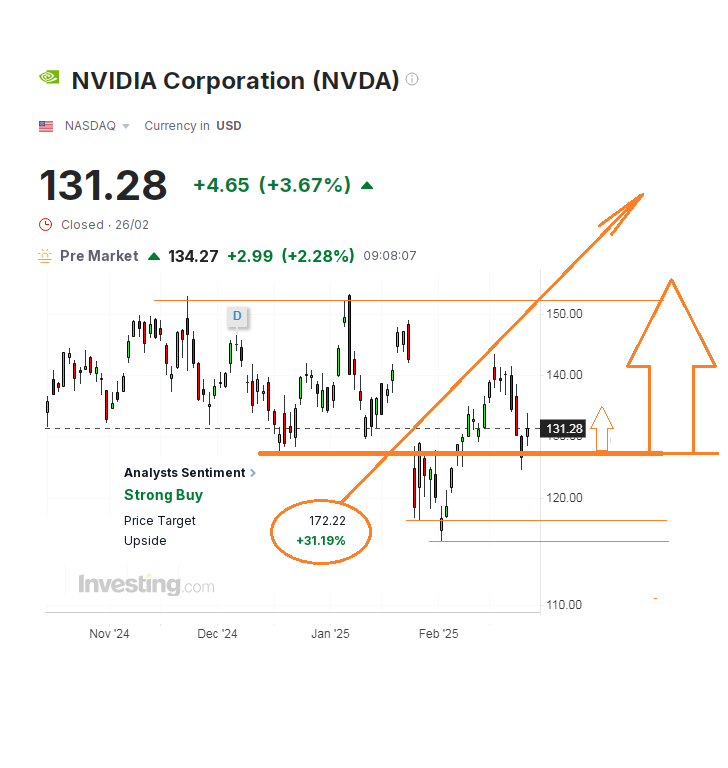The Old AI Horse Won't Mess Up the Furrows
The dogs bark, but the parade goes on. NVIDIA's quarterly report showed solid results last night, so that the AI darling remains at the head of the tech caravan. Wall Street was tensely awaiting metrics from the top blue chip of the last couple of years and even, for a time, the most valuable company in the world after the close of the regular session. That was exactly the moment of doubt for many investors as some giant tech companies including Meta, Amazon and Google indulged into all kinds of corrective price actions. Well, the AI revolution hero has not failed anybody. The smallest news was that NVIDIA happily announced its Q4 EPS (earnings per share) of $0.89 on three-month revenue of $39.3 billion to clearly beat analyst polls estimates of $0.84 on a more than $1 billion smaller revenue of $38.16 billion. However, the best piece of news was that its management freshly projected as much as a 9.4% sales growth to $43 billion, plus or minus 2%, for the current quarter; also well above recent consensus forecast at nearly $41.8 billion. Things just go on in the way I told you before. The new Blackwell series is in high demand, while Chinese "competitors” or still rather NVIDIA's clients, are also ramping up orders for Nvidia's previous Hopper AI chip due to their local boom created by a relative success on a cheaper DeepSeek's model. Only most advanced AI chips can speedily process big data needs and tasks for large players like Microsoft, Amazon etc. Why not chase two hares at once, if NVIDIA has such capacity? NVIDIA's CEO Jensen Huang reiterated that post-training for AI is driving demand as more computing power like the Blackwell ramp is needed for reasoning models, while next-generation AI models would be "even more thoughtful", so that post-training process would require "hundreds, thousands, or perhaps millions" more computing power. Well, big tech companies continue to spend billions of dollars building their AI data centres, and much of that money goes directly to Nvidia. As an example, Meta wants to build its own U.S.-located data centre by investing $200 billion, they just confirmed this week. Jensen Huang noted that the world has "only recently tapped consumer AI", but the next wave is coming: agentic AI, physical AI, and sovereign AI.
A scheduled sensation is not a sensation at all, as Wall Street is tipped for NVIDIA success. Therefore, I feel it's a quite normal phenomenon that its share price seesawed after the release, with prices initially slipping 1.5% to $129 per unit in the first hour of the extended trading on Wednesday and then rising 2.28% above $134 again before the opening bell on Thursday. In any case, there was no sell-out, which is already a sign of strength, meaning that the flagship stayed afloat to help an entire squadron of tech ships to sail on. Even if some unfavourable circumstances of a temporary nature drag, NVIDIA shares to test bottoms around $120 again, like it happened at the end of January, the analyst pool's 12-month target levels above $170 look like a modest hint of even higher achievements. For me, NVIDIA's target for 2025 lies around $200 at least.
As to the further profit potential for NVIDIA stock itself, its CFO Colette Kress commented that gross margins will be "in the low-70s" during the Blackwell ramp, due to Nvidia's commitment to building out manufacturing, but once Blackwell fully ramps, gross margins can "improve to the mid-70s" later this year. In Q4, NVIDIA generated $11 billion of revenue from the Blackwell-related products, which was 50% of the overall data center revenue, she added.
For me, NVIDIA is easily coping with the looming threat of tariff wars and even the potential for further export controls on the delivery of its cutting-edge chips to China. This wild stallion of the modern era could be already called the old AI horse, compared to its younger and low-budget Chinese rivals, but anyway, this is the horse that wouldn't mess up the furrows going straight ahead.

Disclaimer:
The comments, insights, and reviews posted in this section are solely the opinions and perspectives of authors and do not represent the views or endorsements of RHC Investments or its administrators, except if explicitly indicated. RHC Investments provides a platform for users to share their thoughts on financial market news, investing strategies, and related topics. However, we do not guarantee the accuracy, completeness, or reliability of any user-generated content.
Investment Risks and Advice:
Please be aware that all investment decisions involve risks, and the information shared on metadoro.com should not be considered as financial advice. Always conduct thorough research, seek professional advice, and exercise caution when making investment decisions.
Moderation and Monitoring:
While we strive to maintain a respectful and informative environment, we cannot endorse or verify the accuracy of all user-generated content. We reserve the right to moderate, edit, or remove any comments or posts that violate our community guidelines, infringe on intellectual property rights, or contain harmful content.
Content Ownership:
By submitting content to metadoro.com, users grant RHC Investments a non-exclusive, royalty-free license to use, display, and distribute the content. Users are responsible for ensuring they have the necessary rights to share the content they post.
Community Guidelines:
To maintain a positive and respectful community, users are expected to adhere to the community guidelines of Metadoro. Any content that is misleading, offensive, or violates applicable laws and regulations will be subject to moderation or removal.
Changes to Disclaimer:
We reserve the right to update, modify, or amend this disclaimer at any time. Users are encouraged to review this disclaimer periodically to stay informed about any changes.









